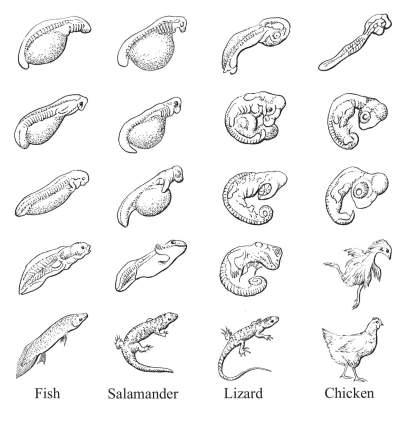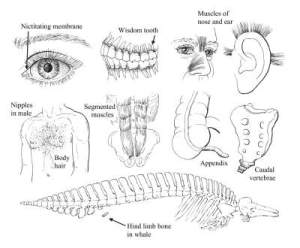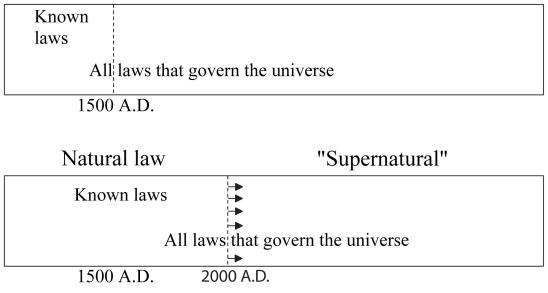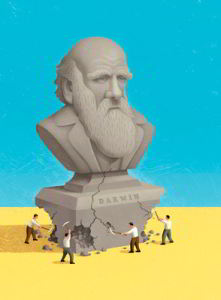The Evidence for Creation
It has been more than 150 years since Darwin published his theory of evolution, and many bookshelves could be filled with books discussing evolutionary theory as it has subsequently developed and giving purported evidence to support it. But when the scientists who write these books analyze the evidence that might tell us something about the history of life on this earth, do they ask the question “Can this data be best explained by Creation, or by evolution?” For 99 per cent or more, the answer is probably No. Most people are educated from their childhood to believe that evolution is true, and thus they consider the principal tenets of the evolution theory to be “known facts.” When they are analyzing scientific data they ask the question “How does this data best fit into the evolution theory?” rather than the broader question “Is this data best explained by evolution, or by Creation?” When we ask that broader question, we find that the data that are often used to support evolution can be equally well explained by Creation.
Microevolution and Macroevolution
In order to simplify our discussion, we can divide evolutionary theory into two parts: microevolution and macroevolution. Microevolution is genetic variation within groups of animals, as within the dog family, or within the various groups of rodents. This type of variation could have occurred since Creation, and thus is not in conflict with the Bible.
The rest of this article will discuss macroevolution—the theory that all of the different groups of animals and plants have evolved from common ancestors. According to this theory, life began in the form of simple one-celled organisms. Some of these developed the characteristics of plants and some evolved into animals, and the plants and the animals gradually evolved into more and more complex levels of organization.
Some of most important kinds of evidence that have been used to support the theory of macroevolution are similarities in the embryos of different kinds of animals, homologous body parts or physiological functions, vestigial organs, and fossils. All of these types of evidence are used in developing phylogenetic trees (diagrams illustrating the presumed evolutionary lines of dissent). but we will demonstrate how this same evidence also supports the biblical story of Creation.
A very young mammal embryo develops a simple kidney, called a pronephros. It is nothing more than a few simple ciliated ducts along the end of a long tubule. A little later, along the same tubule, the embryo develops a series of more complex tubular corpuscles, which come into close contact with knots of blood capillaries. This new kidney is called a mesonephros. The pronephros and the mesonephros function as the organs that clear metabolic waste products out of the blood while the adult kidney, or metanephros, is developing. When the metanephros is fully developed it begins to operate, and the pronephros and mesonephros degenerate and disappear.
Perhaps you are wondering why an embryo goes through the effort of producing a pronephric and mesonephric kidney, and then destroys them. The kidney performs a vital function in clearing metabolic waste products from the blood, and even very young embryos produce waste products that must be disposed of. The simple pronephric kidney can develop quickly, and can keep the blood purified while the larger mesonephric kidney is growing. They continue their operation during the long period of time that it takes for the complex metanephric kidney to grow and begin to function. When that finally happens the simpler kidneys are no longer needed and are broken down.
There are those, however, who believe that this sequence of development from pronephros to mesonephros to meta nephros represents a remnant of our evolutionary past. It has sometimes been said that a mammalian embryo passes through a simple stage with a kidney (pronephros) derived from some primitive ancestor. Then the embryo advances to a higher stage with kidney (mesonephros) similar to a hagfishlike ancestor, and finally reaches the fully evolved mammalian level with its metanephric kidney. It is now recognized, however, that the evidence does not necessarily support that interpretation.
Dr. A. S. Romer, from Harvard, accepts the theory of evolution, but he points out that …
“we see in this story the development in the amniote embryo of three successive kidney structures—pro nephros, mesonephros, metanephros. It is often stated or implied that these three are distinct kidneys which have succeeded one another phylogenetically as they do embryologically. Upon consideration, however, it will be seen that there is no strong reason to believe this. The differences are readily explainable on functional grounds; the three appear to be regionally specialized parts of the original holonephros, which serve different functions. .. . Both mesonephros and metanephros are portions of the opisthonephros; the former is developed rap idly to function in the embryo during the period of the necessarily slower formation of the complex metanephros.” —A. S. Romer, The Vertebrate Body (1965), pp. 283, 284.

Figure 2: Haeckel’s diagram
The theory that embryos pass through stages with kidneys like their evolutionary ancestors is part of a broader theory developed by Ernst Haeckel, called the biogenetic law. According to this theory, an animal’s embryological development (ontogeny) recapitulates, or repeats, its evolutionary history (phylogeny). Haeckel’s original illustration (Fig. 2) is still occasionally printed in popular books or elementary textbooks, even though scientists who study embryology no longer believe Haeckel’s “law.” It is now under stood that in some of the embryonic stages, different kinds of animals do not look as similar as Haeckel drew them. Another point that Haeckel could not have taken into consideration was that even though a young embryo of a mammal, for instance, may look superficially similar to a young fish embryo, the mammal embryo already has the genetic instructions for making the chemical organizers in its cells that will cause it to produce mammal tissues and organs, and not “ancestral” fish structures.
The similarities between the embryos of different kinds of animals can now be explained the same way by creationists and evolutionists. Adult mammals, birds, reptiles, and amphibians look quite different, but they all have a more-or-less oblong body, a head at one end, and most have two limbs at each end of the body. They all begin life as a single cell and follow the same developmental pathway in transforming from one cell to the body-with-the-beginnings-of-ahead- and-four-legs stage. As the head begins to develop, it doesn’t look much like a fully developed head. The limbs at first are only limb buds. The limb buds gradually grow longer, and the head continues to fill out to its mature shape, but the basic vertebrate form is evident be fore the distinguishing characteristics of bird, mammal, or reptile are very obvious, just as the finishing touches on a building do not appear until after the foundation and framework are built. Thus, very young embryos may be expected to look quite similar, and the different characteristics of each group of animals may be expected to appear gradually as the embryo grows.
Vestigial Organs
If animals are evolving we should find vestiges of organs that were once useful and have lost their function, but haven’t quite disappeared yet. A creationist, on the other hand, would not expect to find useless organs, unless degeneration had occurred since Creation. Seventy years ago there was a long list of organs that many biologists considered to be useless, vestigial structures. It is now known that many of these organs perform useful functions, and some (e.g., the adrenals and the pituitary) are essential for life.

Fig. 3: Vestigial Organs
There are a few organs, though, that are still referred to in elementary text books as vestigial (Fig. 3), but these also perform necessary functions. One of these is the tail bone, or coccyx, in humans. This short, stocky bone is com posed of several fused vertebrae and is very important as a point of attachment for the muscles that enable us to stand upright. Another is the appendix, which is not vestigial but is part of the lymphatic system. It helps to remove impurities from the body fluids. The only reason for surgically removing it is be cause it sometimes becomes infected.
Whales do not have hind limbs, but they have small bones, homologous to hind limb bones, completely embedded in flesh. These bones provide a point of attachment for muscles of the reproductive tract, and thus are just another modification of the limb bones to serve a unique function, and there is no convincing reason for believing that they are evolutionary vestiges.
Natural Laws and Miracles
One of the reasons why modern science does not recognize the possibility of divine creation is that it is generally believed that the universe is governed by natural law, and that God could not perform miracles that are contrary to natural law. It is often thought that if He did, the universe (or at least part of it) would appear to be chaotic, instead of the orderly universe that, from our observation, appears to be governed by fixed laws.
However, as a personal being, God can interfere in earth history without necessarily breaking any natural laws. If an apple falls out of a tree the law of gravity dictates that it should fall to the ground. If I catch the apple and thus prevent it from falling to the ground I have not broken the law of gravity, I have merely counteracted it with another law. Certainly God could do the same thing. For example, He could cause a world-wide flood by using His power to alter the normal course of nature.
Another factor that we must recognize is that the laws through which God runs the universe include much more than science normally deals with. We can place these laws in several categories, as follows:
An important difference between “natural” and “supernatural” is that we don’t understand the supernatural. If we could resurrect a man who had lived 1,000 years ago and show him an electric light or a radio, he would undoubtedly be certain that what he was witnessing was a supernatural miracle, because he would not understand the processes and source of power involved.
Creation seems supernatural and unscientific to modern man for the same reason—we do not understand the laws or the source of power involved. The things we call natural and supernatural make up a consistent whole, the total structure within which God runs the universe. We have no way of knowing whether God ever, on rare occasions, performs a miracle that is outside the realm of these laws, but certainly God understands all natural laws, because they are His laws. He made them, and He works through them to accomplish His purposes. Nature is the servant of the Creator, therefore I consider it fair to state that “God does not annul His laws or work contrary to them, but He is continually using them as His instruments” (Patriarchs and Prophets, p. 114).
The more we learn about these laws that govern the universe the more we can comprehend and appreciate the works of God. The coming of the Atomic Age has brought insecurity and fear to the earth, but for the Christian it has made it easier to understand how God can create matter where there was none before. An atomic explosion is produced by the conversion of mass into energy. Knowing that mass and energy are interchangeable makes it easier to grasp the idea that God can create matter, even though we don’t know just how He does it. Perhaps He just reverses the process that occurs in nuclear particle annihilation reactions, and changes some of His great energy into matter.
“O Lord, how manifold are thy works! in wisdom hast thou made them all: the earth is full of thy riches” (Psalm 104: 24).

